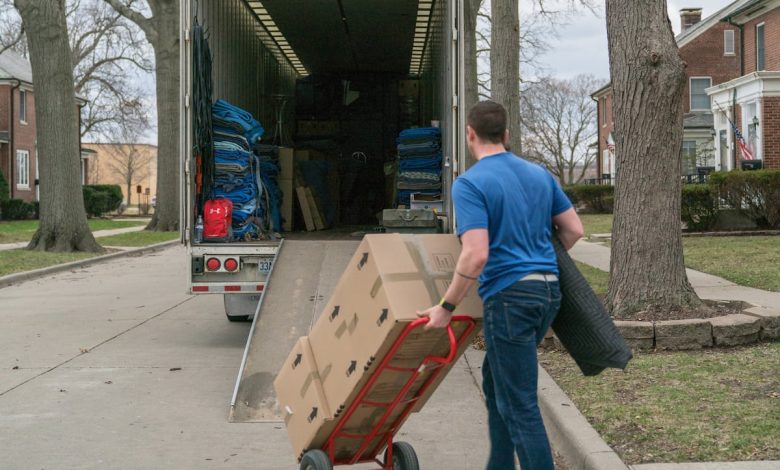DOD trying to head off problems with troops’ household goods moves

In a peak moving season fraught with problems, a new Defense Department task force is trying to proactively identify and correct problems service members may be having with their household goods shipment, the task force commander said Wednesday.
About 450 service members’ household goods shipments remain in various stages of transit by the previous contractor HomeSafe Alliance, officials said, down from the 1,100 shipments in play when the HomeSafe contract was terminated on June 18.
About 30 members of the task force operations team, including the call center, “have been proactively identifying service members who have PCS moves with HomeSafe who could potentially have difficulty with their move, without preventive steps,” said Army Maj. Gen. Lance Curtis, the task force commander, in a Wednesday call with reporters.
On June 18, DOD stopped awarding household goods shipments to HomeSafe, and are awarding all shipments to the legacy system, referred to as “tender of service.”
The task force is also identifying service members moving under the legacy system who are experiencing or could be at risk of experiencing problems, said Army Maj. Pete Nguyen, spokesman for the task force. The task force is working with personal property shipping offices and conducting analysis through the Defense Personal Property System to identify these problems, he said. They’re contacting service members directly and through the personal property offices, he added.
So far, DOD has completed 140,000 household goods move pickups, “and we are on track to complete all moves for 2025,” Nguyen said. “Performance has been on par with previous years, but we are working towards long-term improvements to ensure a positive move experience for every service member in the future.”
Service members who currently have a move in progress, and are experiencing problems, whether with HomeSafe, or with the legacy system, should immediately contact their local transportation office for assistance.
“Every move and circumstance is unique, and deserves individualized attention,” Curtis said, who also announced the creation of a 24/7 call center “from scratch” for service members who are having issues.
Initially on Wednesday, Curtis said HomeSafe Alliance would stop providing shipment services on Friday, July 25, although officials had expected the contractor to continue services into the fall. But Thursday, based on HomeSafe’s assurances that they’ll be able to fulfill their contractual obligations, task force officials decided the services won’t immediately end.
Curtis terminated HomeSafe’s contract June 18 because HomeSafe “failed in its execution of the contract, and that left military families stranded, confused and unsupported,” he said.
Following the contract termination, there was some confusion about HomeSafe’s continued work on the moves in progress, as some HomeSafe movers stopped their work on military moves.
Troops can contact the call center for assistance at 833-MilMove (833-645-6683). Task force officials are staffing and training active duty personnel for that call center, who have completed a move, and understand the frustrations, officials said.
The call center will be fully operational around the beginning of August and available 24/7, Curtis said, but service members can call the number now for assistance.
The task force, directed by Secretary of Defense Pete Hegseth on May 20, includes more than 110 personnel, from all military departments and the Coast Guard, Curtis said. He’s brought in subject matter experts to help with the short- and long-term planning.
Hegseth called for immediate modification of the Defense Personal Property Program, and directed the task force to come up with short-term solutions to address problems during this peak season, as well as recommendations for long-term policy changes. The task force is required to submit those long-term recommendations to Hegseth by Sept. 5.
“We know it’s not working and it’s only getting worse. We’ve heard your concerns about contractor performance quality and accountability. We hear you loud and clear. That’s why we’re taking decisive action immediately,” Hegseth said in a video posted on X in May.
The goal is to provide a system that “better ensures accountability, transparency and real performance of the Defense Personal Property Program,” Curtis said. They’re getting input from military families, household goods experts, the entire moving industry and from command teams across the force, he noted.
HomeSafe had been awarded the Global Household Goods Contract in 2021, worth potentially up to $17.9 billion over nine years, to implement a new process for moving service members’ and their families household goods. HomeSafe was to take over management of the household goods shipment program, while U.S. Transportation Command maintained oversight.
The contract was aimed at fixing long-standing problems with missed pickup and delivery dates, broken and lost items and claims. Defense officials have worked for decades to improve the process for moving families’ household goods. But amid the contract’s rocky rollout this year, families reported delays in getting their household goods picked up and delivered. Problems mounted with HomeSafe’s ability to provide enough capacity to pack, load, truck and unload service members’ belongings.
After the contract was terminated in June, HomeSafe officials said they were confident the contractor “performed to the fullest extent possible considering the limitations placed on it.” Officials said they were disappointed they didn’t have the opportunity to engage with the task force “prior to the contract being terminated without warning.”
Curtis, the task force commander has a message for military families: “To every family who’s moved this summer or is about to move, thank you for your patience, your feedback and your service. You are the reason this task force exists.
“We’re here to support you today and to develop a system worthy of your sacrifice for tomorrow.”
Karen has covered military families, quality of life and consumer issues for Military Times for more than 30 years, and is co-author of a chapter on media coverage of military families in the book “A Battle Plan for Supporting Military Families.” She previously worked for newspapers in Guam, Norfolk, Jacksonville, Fla., and Athens, Ga.
Read the full article here









